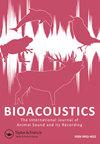Sympatric bush cricket species co-exist across a complex landscape by optimising both acoustic and ecological space
IF 2.1
4区 生物学
Q2 ZOOLOGY
Bioacoustics-The International Journal of Animal Sound and Its Recording
Pub Date : 2021-05-19
DOI:10.1080/09524622.2021.1925589
引用次数: 5
Abstract
ABSTRACT Soundscape comprises of a mix of species-specific calls, where individuals compete for acoustic space, yet a different vegetation structure allows for differential call filtration. We focus on an assemblage of bush cricket species in a human-transformed landscape, with a special focus on the seemingly endangered Thoracistus thyraeus. Landscape transformation produces both novel ecological and acoustic spaces in which species must maintain effective communication. Using acoustic activity and species’ total call times to characterise their response to the different biotopes in the landscape, we determine how species are distributed across the landscape to optimise ecological and acoustic space. We further investigate the distribution of occupied frequency bands to determine whether species are exposed to potential acoustic interference from other sympatric species. We identified 11 bush cricket species and hypothesised that where acoustic interference between species is likely; the different species will be found in different biotopes. We found that acoustic interference between species is low as species co-exist by having distinct ecological resource requirements and inhabit different biotopes, thus preventing acoustic interference from other species. Acoustic and environmental factors play interactive roles in enabling sympatric species to co-exist across complex landscapes, illustrating that these insects can co-exist without acoustic interference.通过优化声学和生态空间,同域灌木蟋蟀物种共存于复杂的景观中
音景由不同物种的叫声混合而成,个体在其中竞争声音空间,但不同的植被结构允许不同的叫声过滤。我们专注于灌木蟋蟀物种的组合在人类改造的景观,特别关注似乎濒临灭绝的胸胸鼠胸腺。景观改造产生了新的生态和声学空间,物种必须在其中保持有效的交流。利用声学活动和物种的总呼叫时间来表征它们对景观中不同生物群落的反应,我们确定了物种如何分布在景观中,以优化生态和声学空间。我们进一步研究了被占用频带的分布,以确定物种是否暴露于来自其他同域物种的潜在声干扰。我们确定了11种灌木蟋蟀,并假设物种之间可能存在声干扰;在不同的生物群落中会发现不同的物种。研究发现,物种间的声干扰较小,因为物种间的生态资源需求不同,物种栖息在不同的生物群落中,从而避免了来自其他物种的声干扰。声学和环境因素在使同域物种能够在复杂的景观中共存方面发挥交互作用,说明这些昆虫可以在没有声学干扰的情况下共存。
本文章由计算机程序翻译,如有差异,请以英文原文为准。
求助全文
约1分钟内获得全文
求助全文
来源期刊
CiteScore
4.50
自引率
0.00%
发文量
25
审稿时长
>12 weeks
期刊介绍:
Bioacoustics primarily publishes high-quality original research papers and reviews on sound communication in birds, mammals, amphibians, reptiles, fish, insects and other invertebrates, including the following topics :
-Communication and related behaviour-
Sound production-
Hearing-
Ontogeny and learning-
Bioacoustics in taxonomy and systematics-
Impacts of noise-
Bioacoustics in environmental monitoring-
Identification techniques and applications-
Recording and analysis-
Equipment and techniques-
Ultrasound and infrasound-
Underwater sound-
Bioacoustical sound structures, patterns, variation and repertoires

 求助内容:
求助内容: 应助结果提醒方式:
应助结果提醒方式:


